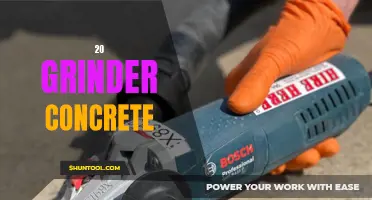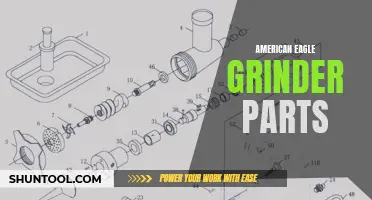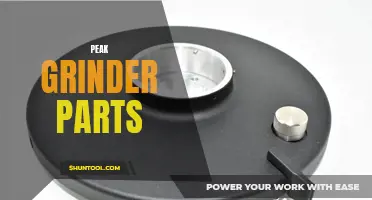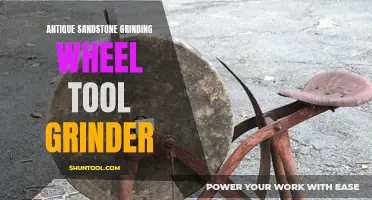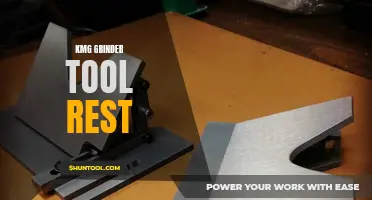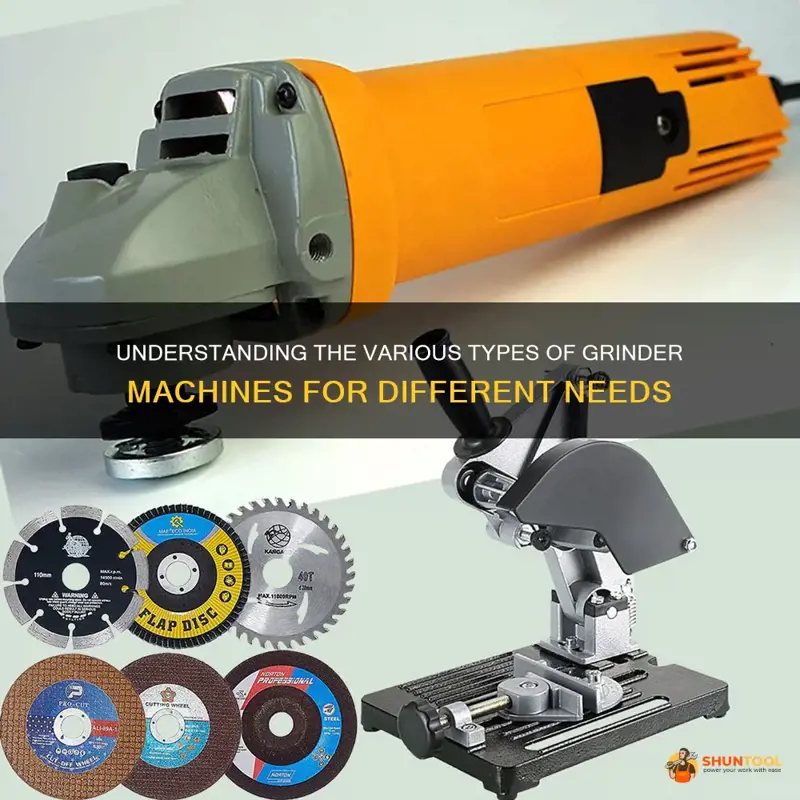
Grinder machines are a versatile tool used in various industries to shape, cut, and polish different materials. From metalworking to woodworking and even food preparation, there are different types of grinder machines available to suit specific needs. Whether you need to remove excess material, sharpen blades, or simply achieve a finer finish, a grinder machine can be your go-to tool. In this article, we will explore some of the most common types of grinder machines and their applications. So, buckle up and get ready for a journey into the world of grinders!
| Characteristics | Values |
|---|---|
| Power | 300W-1500W |
| Speed | 3000-6000 RPM |
| Grinder Type | Angle, Bench, Die, Belt, Surface |
| Disc Diameter | 4-9 inches |
| Weight | 5-15 pounds |
| Voltage | 110V-240V |
| Cord Length | 6-10 feet |
| Noise Level | 70-90 dB |
| Safety Features | Overload protection, lock-on button |
| Accessories Included | Grinding discs, wrench, carrying case |
What You'll Learn

Introduction to Grinder Machines
Grinder machines, also known as grinding machines, are industrial tools that are used for cutting, grinding and polishing surfaces. They come in different shapes and sizes and are commonly used in various industries such as construction, metalworking, and manufacturing.
Grinder machines use an abrasive wheel or belt to perform the desired grinding operation. The abrasive material on the wheel or belt removes material from the workpiece, resulting in a smooth and polished surface. There are different types of grinder machines available, each designed for specific tasks and applications. Let's take a look at some of the common types:
- Bench Grinder: This is the most commonly used type of grinder machine. It is typically mounted on a bench or table and consists of two grinding wheels, one coarse and one fine. Bench grinders are used for sharpening tools, cleaning metal parts, and removing rust or paint.
- Angle Grinder: Also known as a disc grinder or side grinder, an angle grinder is a handheld power tool that uses a rotating abrasive disc to grind, cut, and polish surfaces. It is commonly used in metalworking and construction applications. Angle grinders come in different sizes and can be used with various types of abrasive discs for different tasks.
- Surface Grinder: A surface grinder is used to produce a smooth and flat surface on a workpiece. The machine consists of a grinding wheel that rotates on a horizontal spindle. The workpiece is held in place on a magnetic chuck or a vise while the grinding wheel removes material from the surface.
- Cylindrical Grinder: As the name suggests, a cylindrical grinder is used to grind the outer surface of cylindrical workpieces. It can also be used to create tapered or contoured surfaces. The machine consists of a rotating wheel that is fed along the workpiece to remove material and create the desired shape.
- Tool and Cutter Grinder: This type of grinder machine is used for sharpening or grinding the cutting edges of various tools. It is commonly used in toolrooms and machine shops. The machine can be used to grind different types of tools such as milling cutters, drill bits, and lathe tools.
- Belt Grinder: A belt grinder uses a belt of abrasive material that is stretched between two pulleys. It is commonly used for grinding, deburring, and finishing metal surfaces. Belt grinders are versatile machines that can be used for a wide range of applications, from shaping metal to sharpening blades.
These are just a few examples of the different types of grinder machines available. Each type has its own unique features and specifications that make it suitable for specific tasks. When using a grinder machine, it is important to follow the manufacturer's instructions and observe all safety precautions to ensure safe and efficient operation. Regular maintenance and proper use of the machine will help prolong its lifespan and ensure consistent performance.
Key Considerations When Choosing a Tool Grinder Vise for Precision and Efficiency
You may want to see also

Types of Grinder Machines and their Functions
Grinding machines are tools used for removing excess material from a particular area or workpiece. They are commonly used in metalworking and woodworking, but they can also be used in many other industrial applications. There are several types of grinding machines, each with its specific functions and uses. In this article, we will explore some of the most common types of grinder machines and their respective purposes.
Bench Grinder:
A bench grinder consists of a base, a motor, a grinding wheel, and a supporting tool rest. It is commonly used for sharpening tools, such as chisels, drill bits, and knives. The grinding wheel can be adjusted to different angles to accommodate various tool shapes. Bench grinders are typically compact and can be easily mounted on a workbench for stability.
Cylindrical Grinder:
This type of grinder machine is used to shape the outside of an object. It has the ability to hold and rotate the workpiece while a grinding wheel removes material from the surface. Cylindrical grinders are commonly used in manufacturing and precision grinding applications, where a high level of accuracy and smoothness is required.
Surface Grinder:
As the name suggests, a surface grinder is used for grinding flat surfaces. It consists of a rotating grinding wheel that moves back and forth over the workpiece, creating a smooth and even finish. Surface grinders are widely used in metalworking applications, such as finishing castings, mold and die making, and precision grinding of machine parts.
Tool and Cutter Grinder:
This type of grinder machine is used to sharpen and restore various cutting tools, such as milling cutters, drill bits, and lathe tools. It can also be used to create custom tools and grind complex shapes. Tool and cutter grinders are precise machines that require skilled operators to achieve accurate results.
Jig Grinder:
Jig grinders are specialized machines used for grinding holes and complex contours on a workpiece. The grinding head can be adjusted vertically and horizontally to create precise angles and shapes. Jig grinders are commonly used in tool and die making applications and are known for their high accuracy and repeatability.
Belt Grinder:
A belt grinder uses a stationary abrasive belt to remove material from a workpiece. It is commonly used for shaping and finishing metal or wood. Belt grinders have a wide range of applications, including shaping metal parts, removing burrs, and polishing surfaces. They are often used by metalworkers, knife makers, and woodworkers.
Angle Grinder:
An angle grinder is a handheld power tool used for grinding, cutting, and polishing surfaces. It consists of a motor, a spindle, and a rotating abrasive disc. Angle grinders are versatile tools that can be used for various applications, such as removing rust, grinding welds, and cutting metal or concrete. They are commonly used in construction, metal fabrication, and automotive repair.
Die Grinder:
A die grinder is a handheld power tool similar to an angle grinder, but with a smaller size and higher speed. It is used for grinding, sanding, honing, and polishing various materials, including metal, wood, and plastic. Die grinders are commonly used in metalworking, woodworking, and automotive applications.
In conclusion, there are various types of grinder machines available, each designed for specific applications. Whether you need to sharpen tools, grind flat surfaces, or shape complex contours, there is a grinder machine suitable for your needs. It is important to choose the right type of grinder machine and use it properly to achieve the desired results and ensure safety.
The Versatile Efficiency of the Atlas Tool Post Grinder Belt
You may want to see also

Key Features and Specifications of Grinder Machines
Grinder machines are an essential tool in various industries, allowing workers to shape, sharpen, and polish surfaces with precision and efficiency. These machines come in different types and variations, each designed to meet specific grinding needs. In this blog post, we will explore the key features and specifications of grinder machines, helping you understand their capabilities and choose the right one for your applications.
Power and Motor Size:
One important specification to consider when purchasing a grinder machine is its power and motor size. The power of the motor determines the grinding capacity and the ability to handle different materials. Machines with higher power can grind tougher materials and perform heavy-duty tasks effectively. However, it's important to strike a balance between power and portability, as extremely powerful machines can be bulky and difficult to maneuver.
Wheel Diameter and Speed:
The wheel diameter and speed are crucial factors to consider while selecting a grinder machine. The wheel diameter determines the size and area of the surface being ground, while the speed influences the grinding efficiency. A larger wheel diameter allows for faster material removal and a wider grinding surface. On the other hand, a higher speed enables faster cutting and grinding, making it ideal for precision work. It's essential to choose a machine that offers a balance between wheel diameter and speed, depending on the specific tasks you will be performing.
Adjustable Speed and Variable Control:
Some grinder machines have adjustable speed settings, allowing operators to control the grinding process according to their needs. Adjustable speed is beneficial when working with different materials or when performing tasks that require varying levels of precision. Additionally, machines with variable control options enable operators to choose the right settings for different applications, resulting in improved accuracy and better grinding outcomes.
Dust Collection System:
Grinding surfaces can generate a significant amount of dust and debris, which can be hazardous to the operator's health and compromise the quality of the work. Therefore, it's essential to consider the dust collection system of the grinder machine. Look for machines that feature a built-in dust collection system or can be easily connected to an external dust extraction unit. A good dust collection system not only ensures a cleaner and safer working environment but also prolongs the lifespan of the machine by preventing dust accumulation within sensitive components.
Ease of Use and Safety Features:
The ease of use and safety features are crucial considerations while selecting a grinder machine. Look for machines that have user-friendly controls, ergonomic designs, and intuitive interfaces. Safety features such as overload protection, spark guards, and emergency stop buttons are also essential to ensure the safety of the operator. Additionally, machines with a stable and vibration-free design provide better control and reduce operator fatigue, improving productivity and results.
Accessories and Compatibility:
Lastly, consider the availability of accessories and compatibility options when choosing a grinder machine. Accessories such as different types of grinding wheels, guards, and attachments can enhance the versatility of the machine and allow you to perform a wider range of tasks. Ensure that the machine you choose offers compatibility with standard accessories, allowing for easy replacements and upgrades when needed.
In conclusion, when selecting a grinder machine, consider the key features and specifications to ensure it meets your specific grinding needs. Look for machines with the right power and motor size, suitable wheel diameter and speed, adjustable speed and variable control options, a reliable dust collection system, user-friendly controls and safety features, and compatibility with accessories. By choosing the right grinder machine, you can achieve precise and efficient grinding results, improving the overall productivity and quality of your work.
Building Your Own Tool Grinder: A Step-by-Step Guide
You may want to see also

Considerations for Choosing the Right Grinder Machine
When it comes to choosing the right grinder machine, there are several considerations to keep in mind. The type of grinder you need will depend on the specific task or application you have in mind. In this article, we will discuss the various types of grinder machines and the factors you should consider when making your selection.
- Angle Grinder: This is perhaps the most common type of grinder machine. It is handheld and features a rotating disc for grinding, cutting, and polishing various materials. Angle grinders are versatile and can handle a wide range of tasks, from removing rust and paint to cutting metal and stone. They come in different sizes and power options, so choose one that suits your needs.
- Bench Grinder: As the name suggests, a bench grinder is designed to be mounted on a workbench. It has two grinding wheels, one for coarse grinding and the other for fine grinding. Bench grinders are commonly used for sharpening tools, cleaning metal, and shaping objects. Consider the size of the grinding wheels and the power of the motor when selecting a bench grinder.
- Die Grinder: Die grinders are small, handheld tools used for grinding, sanding, honing, and polishing various materials. They are often used in metalworking and woodworking applications. Die grinders are available in electric and pneumatic (air-powered) versions. Consider the power source, speed control, and the accessories included when choosing a die grinder.
- Surface Grinder: If you need to grind flat surfaces, such as metal sheets or plates, a surface grinder is the right choice. This machine uses a grinding wheel or abrasive belt to remove material from the surface, creating a smooth, flat finish. Surface grinders are commonly used in precision machining and toolmaking industries. Consider the size of the worktable, the power of the motor, and the precision of the grinding mechanism when selecting a surface grinder.
- Cylindrical Grinder: Cylindrical grinders are used to grind cylindrical surfaces, such as shafts or rods. These machines have a rotating grinding wheel that moves along the axis of the workpiece, removing material to achieve the desired shape and size. Cylindrical grinders are commonly used in manufacturing and repair applications. Consider the size of the workpiece, the precision required, and the type of grinding wheel when selecting a cylindrical grinder.
- Centerless Grinder: Centerless grinders are used for high-production grinding of cylindrical parts without centers. This machine consists of a regulating wheel, a grinding wheel, and a workrest blade. Centerless grinders are often used in automotive, aerospace, and medical industries. Consider the size and weight capacity of the parts to be ground, as well as the precision and speed required when selecting a centerless grinder.
When choosing a grinder machine, consider the specific task or application, the size and type of materials you will be working with, and your desired level of precision and control. Take the time to research different models, read reviews, and consult with experts if needed. By considering these factors, you can find the right grinder machine that meets your needs and helps you achieve optimal results.
The Ultimate Guide to the Bed Bath Beyond Superautomatic Espresso Machine with Grinder
You may want to see also
Frequently asked questions
A bench grinder is a tool used for sharpening, shaping, and polishing metal objects. It typically consists of two grinding wheels mounted on a motor-driven spindle.
A coffee grinder is a kitchen appliance used to grind whole coffee beans into a fine powder. This powder can then be used to make coffee using various methods such as drip brewing, espresso, or French press.
An angle grinder is a handheld power tool used for cutting, grinding, and polishing materials such as metal, wood, and concrete. It is commonly used in construction, metalworking, and fabrication projects.
A meat grinder is a kitchen appliance used to finely chop or mince raw or cooked meat. It is commonly used to prepare ingredients for dishes such as sausages, meatballs, burgers, and ground meat for various recipes.


